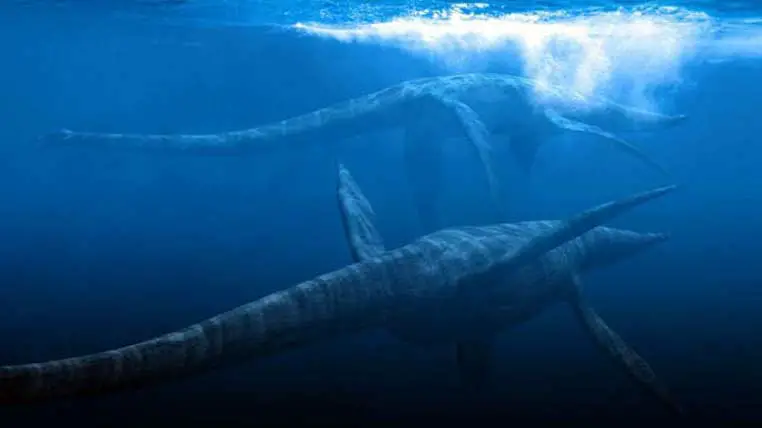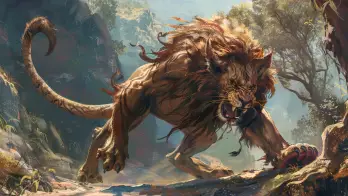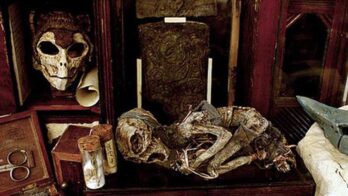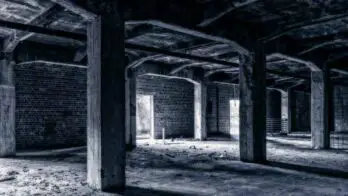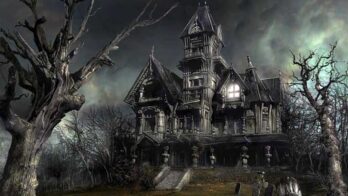Reports of the Loch Ness monster living date back to ancient times. Notably, local Pictish stone carvings depict a mysterious creature with flippers.
The first written account of the creature appeared in a 7th-century biography of St. Columba.
According to the report, in 565 AD, the monster bit a swimmer and was about to attack another person when Columba intervened, commanding the creature to “go back.”
It obeyed, and over the centuries, only infrequent sightings were reported. Many of these supposed encounters appeared to be inspired by Scottish folklore, which is full of mythical water creatures.
The Loch Ness monster legend
In northern Scotland, a freshwater lake called Loch Ness is known for its cold, murky, and mysterious waters. In the Scottish language, “Loch” means “lake.”
The lake is quite vast, approximately 23 miles long (37 kilometers), a mile wide (1,600 meters), and incredibly deep, with a depth of 788 feet (240 meters) at its lowest point.
St. Columba drives off the monster
The first written report of the Loch Ness monster appeared in a 7th-century biography of St. Columba, which described how the creature had attacked a swimmer and was about to attack another man when the saint intervened and ordered the beast to leave.
According to this local legend, a man bathing in River Ness died under bizarre circumstances. St. Columba, who arrived at the scene, met the people who were transporting the lifeless body.
They told him the man had been killed by the monster that dwells in the depths. Intrigued by this possibility, St. Columba asked one of his companions to enter the lake’s cold water to attract the beast’s attention.
According to reports, the animal surfaced and headed threateningly toward the swimmer. While the crowd gathered on the shore watched in horror, St. Columba made the sign of the cross and, in the name of the Lord, commanded the monster to leave.
“When the beast heard the voice of the Saint, it was frightened and began to run back faster than when it had come,” according to a Latin text compiled by Saint Adamnan a century later.
In modern times, more than a thousand people have claimed to have seen Nessie, the creature that locals named decades ago.
However, descriptions of Nessie vary greatly. Some claim the creature resembles a salamander, while others suggest it could be a whale or a seal.
The Loch Ness monster legend lives on
The legend of the Loch Ness monster started to gain popularity in 1933 when a new road opened alongside Loch Ness, providing an unobstructed view of the lake.
In April of that year, a couple reported seeing a massive creature, likened to a “prehistoric monster or dragon,” cross their car’s path and disappear into the water.
The incident was widely publicized in a Scottish newspaper, and other sightings began to be reported.
Later in the year, the Daily Mail hired Marmaduke Wetherell, a famous big-game hunter, to find the sea serpent.
Wetherell discovered large footprints along the lake’s shore, which he thought belonged to “a massive soft-footed creature about 20 feet long.”
Still, the Natural History Museum experts concluded that the marks were all very similar and likely made with an umbrella stand or ashtray with a hippopotamus leg as a base. Wetherell’s role in the hoax was unclear.
Despite the revelation that the footprints were fake, the hunt for the monster continued.
In 1934, English physician Robert Kenneth Wilson took a photo of the alleged creature. The now-iconic picture, known as the “surgeon’s photograph,” seemed to reveal the monster’s tiny head and neck.
The Daily Mail published the image, causing a sensation across the world. Many people assumed the beast was a plesiosaur, an aquatic reptile that went extinct some 65.5 million years ago.
But let’s dive deeper into the fascinating Loch Ness monster legend.
Sightings
Despite numerous sightings over the years, no one has been able to conclusively prove the existence of Nessie.
D. Mackenzie (1871 or 1872)
In either 1871 or 1872, D. Mackenzie of Balnain claimed to have witnessed an object resembling an upturned boat or log that was “wriggling and churning up the water.”
The object moved slowly at first and then disappeared at a faster speed. This account remained unpublished until 1934, when Mackenzie sent a letter to Rupert Gould after public interest in the monster had increased.
Alexander Macdonald (1888)
In 1888, Alexander Macdonald, a mason from Abriachan, reported seeing a “large stubby-legged animal” propelling itself from the loch and surfacing within fifty yards of the shore where Macdonald was standing.
He described the creature as resembling a salamander and reported his sighting to Loch Ness water bailiff, Alex Campbell.
Aldie Mackay (1933)
The most famous article that initially garnered attention about the creature was published in The Inverness Courier on May 2, 1933.
The article, by Alex Campbell, discussed a sighting by Aldie Mackay and her husband John of a giant “beast” or “whale-like fish” with a whale body rolling in the water in the loch as they were driving on the A82 on April 15, 1933.
The word “monster” was supposedly coined in this article, although some reports suggest that editor Evan Barron coined the term.
Campbell’s article was titled “Strange Spectacle in Loch Ness,” and in 2017, The Courier published excerpts from the article, talking about the alleged encounter with the Loch Ness monster.
According to Mackay, the mysterious creature frolicked in the water for a full minute, twirling and diving like a whale.
Its massive body caused the water to churn and cascade like a bubbling cauldron. Suddenly, it vanished into a flurry of foam, leaving the onlookers with an eerie feeling that this was no ordinary inhabitant of the depths.
Its immense size was not the only indication of its strangeness; as it took its final plunge, the creature created waves large enough to have been caused by a passing steamer.
According to a 2013 article, Mackay yelled, “Stop! The Beast!” upon seeing the spectacle.
In the late 1980s, a naturalist questioned Aldie Mackay, and she confessed to knowing there had been an oral legend of a “beast” in the loch well before her alleged sighting.
Campbell’s 1933 report also noted that “Loch Ness has been credited with being the home of a fearsome-looking monster for generations.”
George Spicer (1933)
In 1933, George Spicer and his wife had a sighting of a mysterious creature that sparked modern interest in the Loch Ness Monster.
According to their account, the animal had a large body, stood about 4 feet high, was approximately 25 feet long, and had a long, wavy neck slightly thicker than an elephant’s trunk.
The neck was as long as the width of the road, which was between 10 and 12 feet. Spicer and his wife did not see any limbs, but they saw it lurch across the road and leave a trail of broken undergrowth before disappearing into the loch.
Spicer described the creature as the closest thing to a dragon or prehistoric animal he had ever seen.
He also noted that the creature had an animal in its mouth, and its long neck moved up and down like a scenic railway. The couple saw no feet, but Spicer suggested they might have been webbed.
They also could not say whether the creature had a tail, as it moved too quickly.
The Courier published a report on Spicer’s sighting on August 4, 1933. This triggered a wave of public interest and increased reported sightings of the creature, leading to the name “Loch Ness Monster.”
Hugh Gray (1933)
On November 12, 1933, Hugh Gray allegedly took the first photo of the alleged Loch Ness monster near Foyers.
However, the photograph was slightly blurred, and some researchers suggest that it shows a dog’s head, which Gray had taken for a walk that day.
Others speculate that the photograph depicts an otter or a swan.
The original negative was lost, but in 1963, Maurice Burton received two lantern slides that were contact positives from the original negative.
When projected onto a screen, the two slides showed an otter rolling at the surface in typical style.
Arthur Grant (1934)
On January 5, 1934, Arthur Grant claimed that he nearly hit the creature while approaching Abriachan on a moonlit night.
Grant, a veterinary student, described the creature as having a small head attached to a long neck, and he believed it to be a cross between a seal and a plesiosaur.
He dismounted and followed the creature to the loch, but only saw ripples. Grant produced a sketch of the beast, examined by zoologist Maurice Burton.
Burton stated that the drawing was consistent with the appearance and behavior of an otter.
It has been suggested that Grant may have witnessed either a seal or an otter and embellished his sighting over time due to poor lighting conditions. Paleontologist Darren Naish also supports this hypothesis.
“Surgeon’s photograph” (1934)
The “surgeon’s photograph” is believed to be the first-ever image of the Loch Ness Monster’s head and neck.
It was supposedly captured by Robert Kenneth Wilson, a London gynecologist, and was published in the Daily Mail on April 21, 1934.
However, Wilson declined to be associated with the photo, so it became known as the “surgeon’s photograph.”
According to Wilson, he spotted the monster while looking at the loch, grabbed his camera, and took four photos, of which only two came out clear.
The first photo showed a small head and back, while the second displayed a similar head in a diving position, but it received little attention due to its blurriness.
For 60 years, the photograph was deemed as proof of the monster’s existence, although skeptics dismissed it as an elephant, driftwood, an otter, or a bird.
There was a lot of controversy around the photo’s scale.
It is often cropped, making the creature appear much larger than it is, and the ripples in the water appear to be waves. On the other hand, the uncropped image shows the monster in the center and the other end of the loch.
The ripples in the photo were small in size and pattern, unlike those of large waves captured up close.
After analyzing the original image, further doubts were raised. The Discovery Communications team, who worked on the “Loch Ness Discovered” documentary, studied the uncropped photograph in 1993 and noticed a white object visible in every rendition of the image.
The team suggested that the object was causing the ripples as if it was being pulled, but it was uncertain whether it was a blemish on the negative. Upon analyzing the whole photograph, it was found that the object was only about 60 to 90 cm (2 to 3 ft) long.
Since 1994, most people have agreed that the photo was an elaborate hoax.
Details of how the photo was taken were published in the 1999 book “Nessie – the Surgeon’s Photograph Exposed,” which contained a facsimile of the 1975 Sunday Telegraph article.
The monster in the photo was reported to be a toy submarine created by Christian Spurling, the son-in-law of Marmaduke Wetherell. Wetherell had been publicly mocked by the Daily Mail after he presented “Nessie footprints” that turned out to be a hoax.
To get revenge on the Mail, Wetherell conspired with Ian Wetherell (his son, who bought the material for the fake), Spurling (who was a sculpture specialist), and Maurice Chambers (an insurance agent) to carry out the hoax.
They purchased a toy submarine from F.W. Woolworths and used wood putty to create its head and neck. After testing it in a local pond, they drove off to Loch Ness, where Ian Wetherell took the photos near the Altsaigh Tea House.
When they heard a water bailiff approaching, Duke Wetherell sunk the model with his foot, and most likely, the model is still somewhere in Loch Ness.
Taylor film (1938)
In 1938, a South African tourist, G.E. Taylor, caught an object in Loch Ness on film for three minutes on 16mm color film. Famous science writer Maurice Burton obtained the film but did not show it to other researchers.
In his 1961 book, “The Elusive Monster,” Burton published a single frame from the film and concluded that it was a floating object, not an animal.
William Fraser (1938)
Chief Constable William Fraser of Inverness-shire wrote a letter on August 15, 1938, expressing concern about a hunting party with a custom-made harpoon gun that had arrived and was determined to catch the monster “dead or alive.”
Fraser believed his ability to protect the monster from the hunters was “very unlikely.” The National Archives of Scotland released the letter on April 27, 2010, and Fraser stated that the monster existed beyond doubt.
Sonar readings (1954)
In 1954, the fishing boat Rival III took sonar readings and detected a large object following them at a depth of 146 meters. The crew lost and regained contact after 800 meters, and earlier attempts using sonar were inconclusive or negative.
Peter MacNab (1955)
On July 29, 1955, Peter MacNab captured a photograph at Urquhart Castle depicting two black humps in the water.
The picture was not publicly revealed until it appeared in Constance Whyte’s book in 1957, and in 1958, it was published by the Weekly Scotsman. Some researchers claim the photograph is a hoax.
In 1976, Roy Mackal received the original negative from MacNab for his book, but found it differed from the one in Whyte’s book, suspecting the photograph was doctored by re-photographing a print.
Dinsdale film (1960)
Aeronautical engineer Tim Dinsdale filmed a hump leaving a wake crossing Loch Ness in 1960. He described the object as reddish with a blotch on its side, and the JARIC confirmed that it was “probably animate.”
However, others claimed the “hump” could not be ruled out as a boat. In 1993, a documentary titled Loch Ness Discovered was produced, featuring a digital enhancement of Dinsdale’s film.
The enhancement revealed what appeared to be the rear body of a creature underwater, leading one person to question their previous skepticism.
“Loch Ness Muppet” (1977)
In 1977, Anthony “Doc” Shiels, a magician and psychic, claimed to have summoned the Loch Ness Monster out of the water while camping near Urquhart Castle.
Shiels took pictures of the monster, which he later described as an “elephant squid,” claiming that the long neck shown in the photograph was actually the squid’s “trunk,” and that a white spot at the base of the neck was its eye.
Despite being declared a hoax by many due to the lack of ripples, the photos are still considered some of the clearest pictures of the monster to date.
Holmes video (2007)
In 2007, a laboratory technician, Gordon Holmes, recorded a video of a 14-meter-long black creature moving rapidly in the water, which Adrian Shine, a marine biologist at the Loch Ness 2000 Centre, praised as some of the “best footage [he had] ever seen.”
However, Shine proposed that the creature might have been an otter, seal, or water bird.
Sonar image (2011)
A sonar image of an unidentified object was captured by boat captain Marcus Atkinson on August 24, 2011, which appeared to follow his boat for two minutes at a depth of 23 meters.
Despite ruling out the possibility of it being a small fish or seal, a scientist from the National Oceanography Centre in April 2012 claimed that the image was likely a bloom of algae and zooplankton.
George Edwards photograph (2011)
In 2012, skipper George Edwards claimed to have photographed the Loch Ness Monster, but some researchers doubted the authenticity of his photograph.
Loch Ness researcher Steve Feltham believed the object in the water was a fiberglass hump used in a National Geographic Channel documentary in which Edwards had participated.
Dick Raynor also questioned Edwards’ claim of discovering a deeper bottom of Loch Ness, which he calls “Edwards Deep.”
In a Scientific American survey published in 2013, many hoaxes, including photographs of the Loch Ness monster, have been published since the 1930s.
The science journal deemed Edwards’ 2011 photograph a hoax.
David Elder video (2013)
David Elder, a tourist, captured a mysterious wave in a five-minute video at Loch Ness in 2013. According to Elder, a solid black object measuring 4.5 meters (15 feet) caused the wave just under the water’s surface.
Some skeptics suggested that a wind gust could have caused the wave.
Apple Maps photograph (2014)
In 2014, an Apple Maps satellite image revealed a large creature just below the water’s surface that some believed to be the Loch Ness Monster.
Experts speculated that it could have been the wake of a boat, with the boat itself lost in image stitching or low contrast.
Alternatively, seal-caused ripples or floating wood were also suggested as possible explanations.
Google Street View (2015)
In 2015, Google Street View commemorated the 81st anniversary of the “surgeon’s photograph” with a Google Doodle and added a new feature to Google Street View that allows users to explore the loch above and below the water.
To capture imagery, Google spent a week at Loch Ness collecting data with a street-view “trekker” camera attached to a boat to photograph above the surface.
They also collaborated with members of the Catlin Seaview Survey to photograph underwater.
The hunt for Nessie
There have been many expeditions to search for the Loch Ness monster over the years. Since the first modern sighting in the 1930s, there have been numerous attempts to capture photographic or physical evidence of the creature.
Some expeditions have used high-tech sonar and imaging equipment, while others have relied on traditional methods such as boat patrols and eyewitness interviews.
Edward Mountain expedition (1934)
Edward Mountain sponsored a search for the Loch Ness monster in 1934, prompted by reading Rupert Gould’s book on the creature.
Twenty men positioned themselves around the loch for five weeks, armed with cameras and binoculars from 9 am to 6 pm.
While they did take 21 photographs, none were conclusive.
A film taken by supervisor James Fraser on September 15, 1934, was lost. Still, zoologists and professors of natural history who studied the footage claimed it was likely a seal, perhaps a grey seal.
Loch Ness Phenomena Investigation Bureau (1962–1972)
In 1962 Norman Collins, R. S. R. Fitter, politician David James, Peter Scott, and Constance Whyte formed The Loch Ness Phenomena Investigation Bureau (LNPIB) to study Loch Ness and identify the creature known as the Loch Ness monster.
The society received a $20,000 grant from World Book Encyclopedia in 1967 to fund a two-year program of daylight watches from May to October.
Using 35 mm movie cameras on mobile units with lenses ranging from 20 to 36 inches, they covered approximately 80% of the loch’s surface.
The society disbanded in 1972 after shortening its name to the Loch Ness Investigation Bureau (LNIB).
Volunteers watched the loch with film cameras and telescopic lenses from vantage points. The bureau had a caravan camp and viewing platform at Achnahannet from 1965 to 1972, with observers stationed at other points around the loch.
Its 1969 annual report noted 1,030 members, with 588 from the U.K.
Robert Rines studies (1972, 1975, 2001, 2008)
In 1972, Robert H. Rines, a prominent researcher from the Academy of Applied Science, led a team searching for the Loch Ness monster.
The team used sonar technology to examine the loch depths for unusual activity while taking precautions to avoid murky water with floating wood and peat.
Rines deployed a submersible camera with a floodlight to capture images below the surface. If any activity was detected on the sonar, the camera’s light was switched to capture images.
On August 8, Rines’ Raytheon DE-725C sonar unit identified a moving target, estimated by echo strength to be between 6 to 9 meters in length, operating at a frequency of 200 kHz, and anchored at a depth of 11 meters.
A team of specialists, including experts from Raytheon, Simrad, Hydroacoustics, and MIT, were on hand to examine the data.
They suggested that the data indicated a 3-meter protuberance projecting from one of the echoes.
Although some skeptics believed that the data could be a misinterpreted return from two animals swimming together or a highly flexible laterally flattened tail.
During the sonar readings, the floodlit camera obtained a pair of underwater photographs depicting what appeared to be a rhomboid flipper in different positions, indicating movement.
Both photos were enhanced and retouched from the original negatives. Team member Charles Wyckoff admitted that the images were retouched to superimpose the flipper, with the original enhancement showing a considerably less-distinct object.
In 1975, British naturalist Peter Scott announced, based on the photographs, that the creature’s scientific name would be Nessiteras rhombopteryx.
In 1975, Rines conducted a second search, and some photographs seemed to show unknown animals in various positions and lighting.
One photo showed a plesiosaur-like animal’s head, neck, and upper torso, while another seemed to depict a horned “gargoyle head.”
However, skeptics argued that the objects could be a log due to the lump on its “chest” area and the mass of sediment in the whole photo, and the object’s log-like “skin” texture.
Operation Deepscan (1987)
Operation Deepscan, which took place in 1987, involved deploying 24 boats equipped with echo-sounding equipment across the width of Loch Ness.
As reported by BBC News, these boats simultaneously sent acoustic waves, leading to the identification of an unidentified object of unusual size and strength.
Subsequent rescans of the area revealed images of debris at the bottom of the loch, with motion detected in three of the pictures.
Adrian Shine speculated that the motion could have been caused by seals that had entered the loch, based on their size.
Darrell Lowrance, founder of Lowrance Electronics and a sonar expert, donated several echosounder units used in operation.
Upon examining a sonar return indicating a large, moving object at a depth of 180 meters (590 ft) near Urquhart Bay, Lowrance stated that something present was larger than a fish and possibly a species that had not been detected before.
DNA survey (2018)
In June 2018, an international team of researchers from the universities of Otago, Copenhagen, Hull, and the Highlands and Islands, conducted a DNA survey of the lake to search for unusual species.
The team published the survey results in 2019, revealing no DNA of large fish such as sharks, sturgeons, and catfish could be found. Otter and seal DNA were also not obtained, but the survey found a lot of eel DNA.
Although no eels of extreme size were found, Prof Neil Gemmell, the study’s leader from the University of Otago, could not rule out the possibility of their existence.
He suggested that a large amount of eel DNA may come from many small eels.
The study also found no evidence of any reptilian sequences, leading Prof Gemmell to conclude that there was probably not a giant scaly reptile swimming around in Loch Ness.
Possible explanations of the Loch Ness monster
Sightings of the Loch Ness monster have prompted many explanations, none of which has been proven to account for the mysterious creature.
Ronald Binns, a former Loch Ness Phenomena Investigation Bureau member, suggested that the human psyche tends to see what it wants or expects to see. Therefore, no single explanation exists for the monster.
Binns, who wrote two skeptical books on the subject in 1983 and 2017, believes that the sightings may result from misidentifications of inanimate objects or effects, misidentifications of known animals, hoaxes, reinterpretations of Scottish folklore, and exotic species of large animals.
Binns’ writings are considered the definitive, skeptical account of the Loch Ness Monster phenomenon.
He does not dismiss the sightings as hoaxes but considers them a sociological phenomenon.
Binns contends that after 1983, only a few people remained enthralled with the possibility of the monster’s existence, with eyewitness evidence outweighing all other considerations.
One of the earliest suggestions for Nessie’s identity was a large eel, which could explain many sightings due to the presence of eels in Loch Ness.
However, naturalist Tim Dinsdale dismissed this theory, stating that eels undulate like snakes.
Sightings of a “sea-serpent” or oversized eel in a freshwater lake near Leurbost in the Outer Hebrides in 1856 were explained as misidentifications of known animals believed to be common in Highland lakes.
DNA sampling by scientists from New Zealand in 2018 and 2019 confirmed the presence of European eels in the Loch, with many scientists now believing that giant eels account for most of the sightings.
Another theory posits that the “surgeon’s photograph” was the top of an elephant’s head, extended trunk, and flared nostrils, which were photographed elsewhere and claimed to be from Loch Ness.
Paleontologist and artist Neil Clark suggested in 2006 that traveling circuses may have allowed elephants to bathe in the loch, with the trunk perceived as the head and neck, and the head and back perceived as the humps.
In 2013, zoologist, angler, and television presenter Jeremy Wade investigated the creature as part of the “River Monsters” series and concluded it was a Greenland shark.
The shark can reach up to 20 feet long, is dark in color, and has a small dorsal fin.
Biologist Bruce Wright believes that the Greenland shark could survive in fresh water, using rivers and lakes to find food and that Loch Ness has an abundance of salmon and other fish.
In July 2015, Steve Feltham theorized that the Loch Ness monster is an unusually large specimen of Wels catfish (Silurus glanis), which may have been released during the late 19th century after a vigil at the loch that was recognized by the Guinness Book of Records.
Other resident animals in the Loch may have been misinterpreted as the monster, as it is tough to judge the size of an object in water through binoculars or a telescope and with no external reference.
For instance, photos of otters and deer swimming in the loch cited by author Ronald Binns may have been misidentified.
Birds may also be mistaken for a “head and neck” sighting.
Is the Loch Ness monster real?
The Loch Ness monster, also known as Nessie, has been a topic of interest for numerous monster hunters.
Despite efforts to locate the creature through sonar explorations in 1987 and 2003, it has yet to be found.
Several photographs have been taken of the creature, but most have been discredited as fakes or as images of other animals or objects.
One of the most famous photographs, taken by Robert Wilson in 1934, was later revealed to be a hoax orchestrated by Wetherell, who sought revenge.
The “Loch Ness monster” in the photo was actually a plastic and wooden head attached to a toy submarine.
In 2018, researchers conducted a DNA survey of Loch Ness to identify the organisms living in its waters.
The survey found no evidence of a plesiosaur or any other large animal but revealed many eels. This discovery raised the possibility that the monster could be an oversized eel.
While we don’t have any conclusive evidence, the Loch Ness monster remains a popular and profitable phenomenon. In fact, it is estimated to contribute almost $80 million annually to Scotland’s economy.
At Ancient Theory we only use trusted sources to document our articles. Such relevant sources include authentic documents, newspaper and magazine articles, established authors, or reputable websites.
- Loch Ness monster. britannica.com. [Source]
- Loch Ness Monster was sighted for the first time, igniting the modern legend. history.com. [Source]
- Loch Ness Monster may be a giant eel, say scientists. bbc.com. [Source]
- Dr. Darren Naish - How do we know that the Loch Ness Monster doesn’t exist? sciencefocus.com.
- Jason Gilchrist - Have scientists finally killed off the Loch Ness Monster? theconversation.com.
- The Loch Ness Monster. nature.com.
- Aug 22, 564 CE: Loch Ness Monster Sighted. nationalgeographic.com. [Source]
- Ross Mcindoe - Is the Loch Ness Monster real? Sightings, pictures, and whether Scotland's famous creature really exists. scotsman.com.
- Stephen Lyons - The Legend of Loch Ness. [Source]
- Rachel E. Greenspan - Thousands Have Signed Up' to 'Storm Loch Ness and Find That Big Boy. Here's the History Behind the Mythical Sea Monster. time.com.
